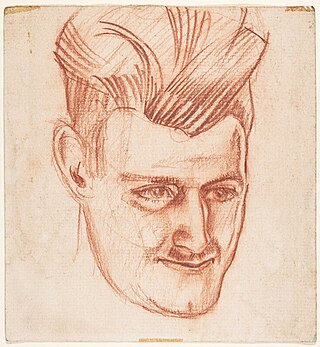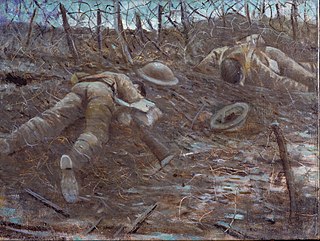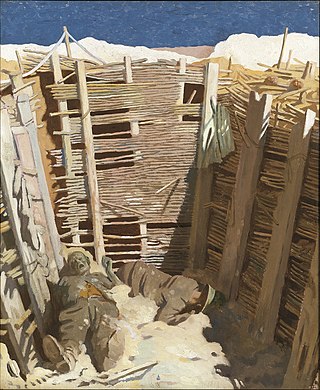Lieutenant-Colonel Arthur N. Lee, DSO, OBE, (August 1877- October 1954) was the British military censor in France of paintings by official British war artists during World War I from 1916 to the Peace. [1]
Lieutenant-Colonel Arthur N. Lee, DSO, OBE, (August 1877- October 1954) was the British military censor in France of paintings by official British war artists during World War I from 1916 to the Peace. [1]

Lee was born in Southwell, Nottinghamshire and attended Trinity College, Cambridge, graduating in 1899 and subsequently qualified as a solicitor before becoming a director of the Sheffield cutlery manufacturers Walker & Hall. He was a territorial officer with the Sherwood Foresters from 1903 and on the outbreak of World War I was mobilised with his regiment and sent to the Western Front. In 1916 he served as a Major in Dublin where the Sherwood Foresters suffered heavy losses during the Easter Rising and was awarded the DSO. He was then transferred to the HQ of the British Expeditionary Force as a Lieutenant-Colonel where he was appointed military censor. He had several well-recorded disputes with war artists, particularly William Orpen and Christopher Nevinson whose Paths of Glory Lee attempted to censor. Nevinson, however, still exhibited the work at a London exhibition in 1918 with a piece of brown paper across it bearing the word "Censored". Lee was awarded an OBE for his war work. [2]
After the war, Lee returned to Sheffield and his cutlery firm. In 1932 he served as Master Cutler [3] of the Company of Cutlers. Lee, who had become a friend of William Orpen continued the friendship until Orpen's death in 1931 and was responsible for commissioning Orpen to paint Edward, Prince of Wales in 1923 on behalf of The Royal and Ancient Golf Club of St Andrews of which Lee was a committee member. [4] Lee's personal papers were donated to the Imperial War Museum after his death, by his son Peter Murray Lee who had served as an intelligence officer in World War II.

Christopher Richard Wynne Nevinson was an English figure and landscape painter, etcher and lithographer, who was one of the most famous war artists of World War I. He is often referred to by his initials C. R. W. Nevinson, and was also known as Richard.

George Vere Arundel Monckton-Arundell, 8th Viscount Galway, was a British politician. He served as the fifth Governor-General of New Zealand from 1935 to 1941.

Major Sir William Newenham Montague Orpen, was an Irish artist who worked mainly in London. Orpen was a fine draughtsman and a popular, commercially successful painter of portraits for the well-to-do in Edwardian society, though many of his most striking paintings are self-portraits.
Events from the year 1918 in art.

The Sherwood Foresters was a line infantry regiment of the British Army in existence for just under 90 years, from 1881 to 1970. In 1970, the regiment was amalgamated with the Worcestershire Regiment to form the Worcestershire and Sherwood Foresters Regiment, which in 2007 was amalgamated with the Cheshire Regiment and the Staffordshire Regiment to form the present Mercian Regiment. The lineage of the Sherwood Foresters is now continued by The Mercian Regiment.

Eric Henri Kennington was an English sculptor, artist and illustrator, and an official war artist in both of the world wars.

The First World War, which was fought between 1914 and 1918, had an immediate impact on popular culture. In the over a hundred years since the war ended, the war has resulted in many artistic and cultural works from all sides and nations that participated in the war. This included artworks, books, poems, films, television, music, and more recently, video games. Many of these pieces were created by soldiers who took part in the war.
Lieutenant General Sir Henry Beresford Dennitts Willcox KCIE CB DSO MC was a British Army officer who served during World War I and World War II.
The Royal North Devon Yeomanry was a Yeomanry regiment of the British Army. First raised in 1798, it participated in the Second Boer War and the First World War before being amalgamated with the Royal 1st Devon Yeomanry in 1920 to form the Royal Devon Yeomanry.
The King's Birthday Honours 1923 were appointments in many of the Commonwealth realms of King George V to various orders and honours to reward and highlight good works by citizens of those countries. The appointments were made to celebrate the official birthday of The King. They were published on 1 and 29 June 1923.

Paths of Glory is a 1917 painting by British artist C. R. W. Nevinson. The title quotes from a line from Thomas Gray's 1750 poem Elegy Written in a Country Churchyard: "The paths of glory lead but to the grave". It is held by the Imperial War Museum in London, which describes it as "one of Nevinson's most famous paintings".
The Hall of Remembrance was a series of paintings and sculptures commissioned, in 1918, by the British War Memorials Committee of the British Ministry of Information in commemoration of the dead of World War I.

To the Unknown British Soldier in France is an oil-on-canvas painting by Irish artist Sir William Orpen, exhibited in one state in 1923 and then modified in 1927. It was one of three paintings commissioned from Orpen to commemorate the Peace Conference at Versailles in 1919. The work is held by the Imperial War Museum in London.
The New Year Honours 1923 were appointments by King George V to various orders and honours to reward and highlight good works by members of the British Empire. They were published on 29 December 1922.
The New Year Honours 1922 were appointments by King George V to various orders and honours to reward and highlight good works by members of the British Empire. They were published on 30 December 1921.
The King's Birthday Honours 1930 were appointments by King George V to various orders and honours to reward and highlight good works by members of the British Empire. The appointments were made to celebrate the official birthday of The King. They were published on 30 May 1930.
The 1924 Birthday Honours were appointments by King George V to various orders and honours to reward and highlight good works by citizens of the British Empire. The appointments were made to celebrate the official birthday of The King, and were published in The London Gazette on 3 June 1924.
The 1925 Birthday Honours were appointments by King George V to various orders and honours to reward and highlight good works by citizens of the British Empire. The appointments were made to celebrate the official birthday of The King, and were published in The London Gazette on 3 June 1925.

Dead Germans in a Trench is a 1918 oil painting by Irish artist William Orpen, made during the First World War. It was inspired by the battlefield of the Battle of the Somme that Orpen had visited in 1917, and depicts the bodies of two dead German soldiers sinking into the mud at the bottom of a trench.